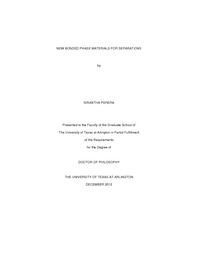
ATTENTION: The works hosted here are being migrated to a new repository that will consolidate resources, improve discoverability, and better show UTA's research impact on the global community. We will update authors as the migration progresses. Please see MavMatrix for more information.
Show simple item record
| dc.contributor.author | Perera, Sirantha | en_US |
| dc.date.accessioned | 2013-03-20T19:12:17Z | |
| dc.date.available | 2013-03-20T19:12:17Z | |
| dc.date.issued | 2013-03-20 | |
| dc.date.submitted | January 2012 | en_US |
| dc.identifier.other | DISS-11938 | en_US |
| dc.identifier.uri | http://hdl.handle.net/10106/11593 | |
| dc.description.abstract | Separations play an important role in day to day life as well as in science and technology. This dissertation focuses on novel and versatile techniques involving synthesizing new bonded chiral stationary phases (CSPs) and using existing CSPs for the separation of target chiral analytes in HPLC. It also includes development of new ionic liquid (IL) based silica bonded polymeric coatings for solid phase microextraction gas chromatography (SPME-GC) in headspace and direct immersion for polar analytes and finally, coupling new MALDI matrix bonded SPME fibers and laser desorption for rapid identification of biological materials. Enantiomerically pure Ru complexes were introduced as novel bonded chiral stationary phases. Among the three binding chemistries to the silica gel studied, reductive animation of aldehyde-functionlized silica worked best. The Ru complex-bonded CSP provided enantioselectivity in the polar organic mode toward compounds with acidic groups and binaphthyl type compounds in the normal phase mode. Next the two best aromatic-functionalized cyclofructan-based CSPs, R-napthylethyl-carbamate cyclofructan (RN-CF6) and dimethylphenyl-carbamate cyclofructan 7 (DMP-CF7) were synthesized and evaluated with different classes of chiral analytes. These two CSPs showed enantioselectivity toward a broad range of compounds such as chiral acids, amines, metal complexes and neutral compounds.In another study, twelve types of commercial CSPs (cyclodextrin types and cyclofructan types) were evaluated by separating newly synthesized seventeen racemic tetrahydrobenzimidazole analytes. Among the twelve different CSPs, enantiomeric recognition was most frequently observered with Cyclobond RN and LARIHC CF6-P while the Cyclobond DMP yielded the greatest number of baseline separations in HPLC. Four new ionic liquids (ILs) were prepared and bonded onto 5 µm silica particles for use as adsorbents in SPME. The two polymeric IL fibers were effective in headspace SPME for short chain alcohols. Immersion SPME can be used with the polymeric IL fibers for short chain alcohols and for polar and basic amines. Their efficacy compares favorably to that of commercial fibers for polar analytes in both modes. The mechanical strength and durability of the polymeric fibers were excellent. Finally, 3-hydroxy-2-naphthoic acid (HNA) and 2-hydroxy-1-(2-hydroxy-4-sulfo-1-naphthylazo)-3-naphtoic acid (HHSNNA) were tested as MALDI matrices for peptides and proteins and compared to two classical matrices: á-cyano-4-hydroxycinnamic acid (CHCA) and 2,5-dihydrobenzoic acid (DHB). HNA was found to be a good MALDI matrix comparing well with DHB and CHCA. The proton-donor compounds were covalently bound to silica particles of different pore diameters. Only the wide pore silica material gave observable MALDI spectra. The wide pore bonded silica materials were then attached in a thin layer onto wires to be used as fiber tips in SPME peptide extractions. The peptide adsorbed to the SPME fibers were introduced into the mass spectrometer for fiber laser desorption ionization (FILDI) spectrum recording. | en_US |
| dc.description.sponsorship | Armstrong, Daniel | en_US |
| dc.language.iso | en | en_US |
| dc.publisher | Chemistry & Biochemistry | en_US |
| dc.title | New Bonded Phase Materials For Separtions | en_US |
| dc.type | Ph.D. | en_US |
| dc.contributor.committeeChair | Armstrong, Daniel W. | en_US |
| dc.degree.department | Chemistry & Biochemistry | en_US |
| dc.degree.discipline | Chemistry & Biochemistry | en_US |
| dc.degree.grantor | University of Texas at Arlington | en_US |
| dc.degree.level | doctoral | en_US |
| dc.degree.name | Ph.D. | en_US |
Files in this item
- Name:
- Perera_uta_2502D_11938.pdf
- Size:
- 3.093Mb
- Format:
- PDF
This item appears in the following Collection(s)
Show simple item record


